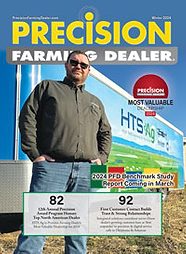Controlled tire inflation systems (CTIS) could offer a new precision niche for dealers, but cost and education are delaying adoption in North America.
While the European agricultural market is considered a leader in development and implementation of precision farming practices, the technology doesn’t always transition smoothly to North America.
For example, ISOBUS compatibility remains a challenge in the states, despite having been incorporated overseas more than a decade ago.
Another technology that is well-established in Europe, but lesser known in North America is Central Tire Inflation Systems (CTIS). These systems, discussed with Precision Farming Dealer at Michelin’s recent Field of Dreams media event in Europe, give farmers the ability to monitor and change tire pressure on the fly, automatically, as they move from the road to the field.
“One of the big focuses in the global market is soil compaction and this is getting more attention in North America, as equipment gets larger and heavier,” says James Crouch, farm segment marketing manager with Michelin. “Right now, farmers set up their tire inflation for worst case scenario, for maximum load and maximum speed. But they should be inflating for best case scenario, changing for optimum pressure on the road and lowering it for the field to create a larger footprint and less compaction.”
Some equipment manufacturers, including Fendt, have recently introduced CTIS systems on new tractor lines in North America, but it’s largely an aftermarket technology, which is where precision dealers could carve out a niche, says John Casner, president of Inflation Solutions LLC based in Fletcher, Ohio.
James Crouch, farm segment marketing manager for Michelin North America, discusses the benefits of Central Tire Inflation Systems (CTIS), it's origin in Europe and it's emergence in North American agriculture.
“There is huge market potential, because right now there’s not much from the OEMs for CTIS,” he says. “Even when they do start developing these systems, there will be service needs and the opportunity to retrofit a lot of the older equipment with these systems.”
Solutions is one of a handful of companies selling and servicing CTIS systems for agricultural machinery in North America. They are a distributor of PTG Central Tire Inflation Systems, a German-based manufacturer.
The dual-line systems for tractors include a hydraulic drive air compressor attached to the wheel and operated by remote. There is a monitoring system in the cab, where the operator sets high and low pressure points for each axle. Tire pressure is changed with a touch of a button to accommodate for road or field driving conditions.
“Every tire has an ideal air pressure based on weight exchange and weight needed to achieve 100% performance,” Casner says. “But farmers aren’t maximizing that potential and that can cost them yield.”
Studies conducted by the company have shown that running a 16-row, 40-foot front-fold corn planter in the field with the same high tire pressure as on the road can cost a farmer upwards of 30 bushels per acre on pinch rows, due to compaction.
Casner says this can be strong selling point, but there are nevertheless challenges to convincing customers to purchase the system. The PTG systems can cost upwards of $12,000 and adding precision technology to tires isn’t necessarily a priority for farmers.
Still, both Crouch and Casner expect the North American market to expand in the coming years, as farmers seek new outlets to increase efficiency and improve productivity. “I’m sure OEMs are working on long-term projects to bring this technology to North America because there is such a benefit,” Crouch says. “It’s inevitable that we’ll see it here soon.”
Casner agrees and expects that in the future, more tractors will come factory installed with CTIS systems, integrated into the manufacturer’s precision display in the tractor cab.
“John Deere did an initial release of about 50 of their 7000 series tractors in Germany with PTG systems installed at the factory run through their monitor,” Casner says. “Eventually, we’ll start to see more of this coming to North America and there is a chance to pull customers into the technology, rather than push them.”







Post a comment
Report Abusive Comment